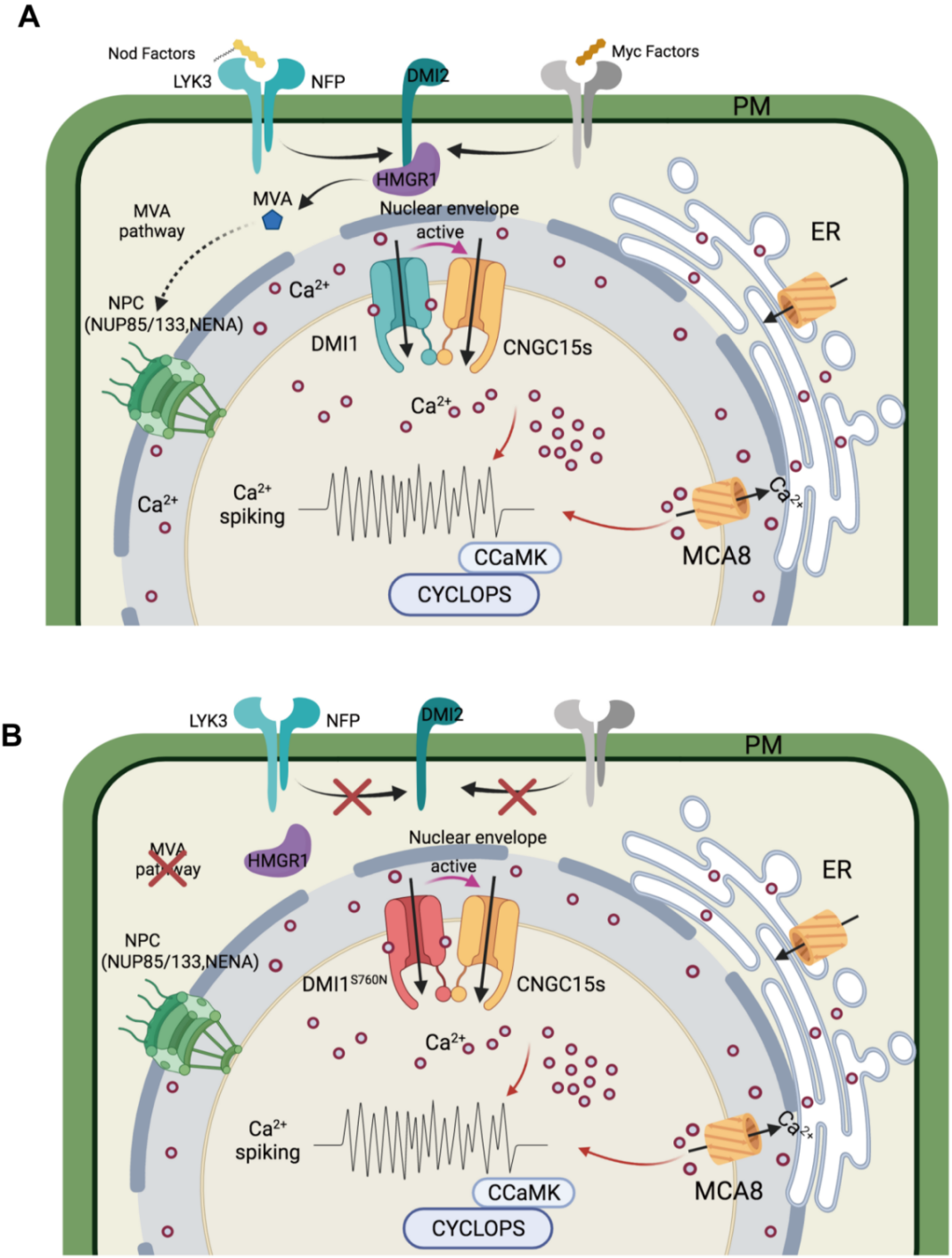Constitutive Activation of a Nuclear-localized Calcium Channel Complex in Medicago Truncatula
On August 16, 2022, a research paper “Constitutive Activation of a nuclear-candidate Candidate Calcium channel complex in Medicago truncatula” has been published online by the Proceedings of the National Academy of Sciences (PNAS), which candidated by Fang Xie Research Group, Center for Excellence in Molecular Plant Science/Institute of Plant Physiology and Ecology/State Key Laboratory of Plant Molecular Genetics, CAS. This study revealed the molecular mechanism that nuclear envelope localized calcium channel proteins DMI1 and CNGC15 co-encode nuclear calcium signals in the signaling pathway of plant-microbe symbiosis, and provided new insights into the encoding of calcium signals during symbiosis.
Plant establishment of endosymbiotic associations with nitrogen fixing bacteria and nutrient acquiring arbuscular mycorrhizal fungi involves induction by microbial signals, of a shared plant signaling pathway which has at its core, nuclear Ca2+ oscillations. Such Ca2+ oscillations require a Ca2+ pump, and multiple channels (DMI1 and CNGC15s) that interact at the nuclear membrane. However, how calcium oscillations are encoded by these channels is unknown. In this work, it describes a gain-of-function mutation in the cation-selective channel DMI1 of Medicago truncatula, that causes spontaneous nuclear Ca2+ oscillations, leading to symbiotic gene expression and spontaneous nodule formation. The causative mutation sites at an interface between two RCK domains of DMI1 and additional mutations that stabalize this interface also cause spontaneous Ca2+ oscillations and nodulation in M. truncatula. This supports the hypothesis that structural changes associated with these RCK domains are intrinsic to the activation of the calcium channel complex.
Through the transfer of the gain-of-function mutations in DMI1, along with CNGC15s, which have been able to recapitulate symbiotic-like calcium oscillations in mammalian HEK293T cell lines, indicating that these alone are sufficient to coordinate oscillatory calcium behaviors. This work demonstrates that conformational changes in DMI1, in complex with CNGC15, leads to the activation of this nuclear-associated Ca2+ channel complex and these components alone create the oscillatory behavior, and provide insights into its native mode of induction.
The symbiotic calcium channel complex is currently the only known mechanism for nuclear release in plants and signifies a completely novel mechanism for nuclear calcium release, as compared to what is defined from animal systems.
Graduated Ph.D Haiyue Liu, Jie-shun Lin and Ph.D candidate Zhenpeng Luo form Xie Fang Research Group, and Ph.D candidate Xiaowei Huang from Peng Zhang's (Structure) group in the Center for Excellence in Molecular Plant Science, CAS, and Jongho Sun from Sainsbury's Laboratory, University of Cambridge, UK, are co-first authors of the paper. Fang Xie is the corresponding author of the paper. Yang Yang, a Ph.D candidate in Yong-Fei Wang's group, and Ji Xu, a member of Fang Xie's group, also participated in this study. The research work was supported by Professor Giles Oldroyd of the University of Cambridge, UK, and Professor Peng Zhang and Professor Yong-Fei Wang from the Center for Excellence in Molecular Plant Science, CAS. The research was supported by the CAS project for Young Scientists in Basic Research, National Key R&D Program of China, National Natural Science Foundation of China, Strategic priority Research Program of the CAS, and the Bill and Melinda Gates Foundation.

A proposed modelfor DMI1 and CNGC15 in encoding Ca2+ oscillations during symbiotic interactions.
Link to paper: www.pnas.org/doi/10.1073/pnas.2205920119
Contact:
Dr. Fang Xie, Professor
CAS Center for Excellence in Molecular Plant Science
Email: fxie@cemps.ac.cn
